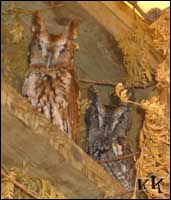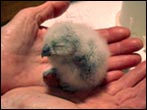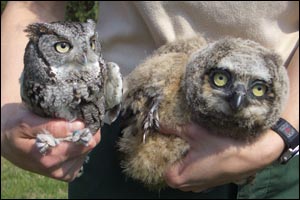 |
............... |  |
 |
| Adult
Red and Grey Phases |
Nestling |
Fledgling
(red morph) |
The Owl Foundation receives more Eastern Screech Owls each year than any other owl species (30 - 50 birds). This is because the Screech Owl is a very common species throughout the southern regions of eastern Canada and has a tendency to frequent urban areas. Nest trees are regularly felled in spring by storms or people, leaving orphaned owlets hungry and cold. Adults are often hit by cars while hunting near roads (there are more mice near the roads because of garbage in ditches) and survivors commonly incur permanent eye or neurological injuries deeming them unreleasable. Unfortunately, many of these casualties also leave behind families.
Screech Owls fall into two general colour morphs: grey and red. However, there are intermediate brown colour phases. Like the Great Horned Owl (Bubo virginianus), this colouration is genetic (the red allele being recessive and grey dominant) and permanent. Owls do not switch between morphs through their lives.
Screech Owls are often confused as young Great Horned Owls because both species boast conspicuous ear tufts. There are a few differences to look for though:
- Screeches have bone
coloured beaks. Great Horned Owls, even babies, will have black beaks.
- Adult Screech Owls reach
a maximum size of about 6 inches in height (or about 9 inches in length).
They have adult plumage complete with variations of brown, black and
white feathers. Nestling Screech owls are smaller and fuzzy.
They have greyish down feathers all over their bodies, regardless of
their eventual colour phase (see above).
Great Horned Owl babies also have fuzzy natal down all over their bodies but will be well beyond the size of your average adult Screech Owl just a few weekd after hatching (see below). By the time a young Great Horned Owl begins growing its adult feathers, it is much much larger than a Screech Owl.
Side by side it is easy to see the difference between an adult Eastern Screech Owl and a nestling Great Horned Owl. Notice the soft natal down feathers of the Horned Owl in contrast to the grey adult plumage of the Screech.
Screech Owls are rarely seen by visitors to the Foundation. As one of Canada's smaller owl species, this is not too surprising. Their mottled and barred feathering camouflages their slender, stretched bodies as they imitate trees. Some prefer to spend daylight hours hidden in roost boxes and are rarely even seen by staff.
Vocalizations:
This owl probably gets its name from the screeching call it gives when scared, but may come from its typical whinnying vocalization. This typical courtship call resembles the "hoooOOOooo" people reserve for ghostly sounds. A low, resonating territorial trill often accompanies a series of whinnies. Eastern Screech Owls will also produce single (and rarely multiple) hoots when surprised. Nestlings reap for food.
The Western Screech Owl
is virtually identical to the Eastern. The former has a darker beak and
an accelerating courtship call very dissimilar from that of the latter.
Vocalizations |
||
|
|
||
| |
This
is the typical courtship call given by adult owls. Most often given
in spring, it is also used throughout winter. |
|
Whinny |
||
|
|
||
| A
call sometimes heard during handling. |
||
Screech |
||
|
|
||
| Usually produced between whinnies. | ||
Territorial
Trill |
||
| Rarely
given in series - a typical hoot. |
||
Hoot |
||
| This strange noise is produced by only a few Screeches when they are approached too closely. | ||
Warning |
||
|
|
||
| Given
as a result of hungry stomachs. |
||
Nestling
Food Cry |
||
|
|
||
| Defensive
scare tactic produced by snapping the tongue against the roof of
the mouth. All owls seem to clack. |
||
Clack |
||
|
|
||
|
|
||
Contact
Us | Hours | Home
| Legal
© 2008 The Owl Foundation
Owl vocalizations recorded by Kara Kristjanson.
Unless otherwise stated, all photographs and sound files are the property of The Owl Foundation.
No images or sounds on this website are to be duplicated in any way without express written permission
from the party to which they belong.
If you are interested in receiving quality versions, please contact The Owl Foundation.

